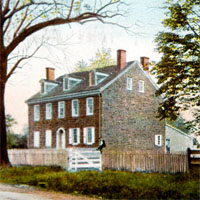In the photo, from the 1914 Pageant program:
- LADY NARBERTH,
QUEEN OF THE PAGEANT - Mrs. George M. Henry
- PAGES
- Robert Savill
- Robert Leland
Behold "Lady Narberth, Queen of the Pageant, and the ladies-in-waiting and pages". The pageant was Narberth Day Fête and Historical Pageant, presented June 26-27, 1914, the debut project of the three-month-old Narberth Civic Association (NCA). A cast and crew of over 200 (10% of the population in 1914!) took up the roles of Indians, Welsh settlers and town founders. Many of the founders were played by their adult children or grandchildren.

The Pageant, held in anticipation of the the Borough's 20th anniversary, clearly seeks to create a history and sense of identity for the new community. Was it charming, inspiring, embarrassing? Read the program (PDF, 1.5MB), which contains this photo, and draw your own conclusion. Lady Narberth delivered no lines; to fanfare and trumpet blast, she regally processed and, at the conclusion, recessed, followed by her ladies, flower girls and two pages holding her long train.
The location of the performance was announced in the Ardmore Chronicle as "Jacob's Ball Field at the west end of Elmwood Avenue". On the 1913 map, this area was marked as the property of "Ins. Co. State of Pa." By 1919, 3 Elmwood had been built here, owned by Harry A. Jacobs. Jacobs served as editor of Our Town from October 14, 1915 through March 12, 1921. He succeeded its first editor, Mrs. C. R. Blackall, director of the Fête and Pageant.


What did contemporaries think of the Fête?
In announcing the upcoming event, the Ardmore Chronicle and the Philadelphia Inquirer used the identical phrase "It is a pretentious program that the Civic Association has arranged". They may have been quoting a press release, but it's a curious wording. Did "pretentious" have an alternative meaning in 1914?
Notwithstanding, the Inquirer's review after the first performance (PDF, 933 KB) was quite complimentary:
…one of the most colorful and unique celebrations any community of similar size has ever attempted. The "All-year-'Round Home Town," as Narberth has been called since its wide-awake civic association decided upon that slogan, showed that it could do great things today in exactly the right way. …a crowd of 10,000 or 15,000 is expected to witness the pageant and the other features.
And the following day, at the close of the two-day celebration: "It showed that Narberth could tackle a mighty big thing and do it right.… Narberth stands foremost among communitites that can do things." (Philadelphia Inquirer, June 28, 1914, page 2)
The Survey, "a weekly journal of constructive philanthropy" published in New York City, went further. It asserted that the pageant "resulted in a kind of social regeneration within the community. Families...now are real neighbors and are working hand in hand to make Narberth a better place in which to live. Finally, the pageant put Narberth on the map, favorably."
Mrs. George M. Henry

Lady Narberth, a.k.a. Elise K. Henry, lived at 107 Chestnut, which we glean from reading "The Fireside", the social column in Our Town, Narberth's weekly newspaper 1914 - 1949, the NCA's next big project. Lady Narberth reprised her pseudonym as its author during its first year. She also served as a Director of the NCA.
Mr. George M. Henry was the NCA's first president, a driving force behind the development of Narbrook Park and Narberth's burgess from 1914 to 1918. Nevertheless, the Henrys had left Narberth for Berwyn by 1920.
Updated August 28, 2025.










































































